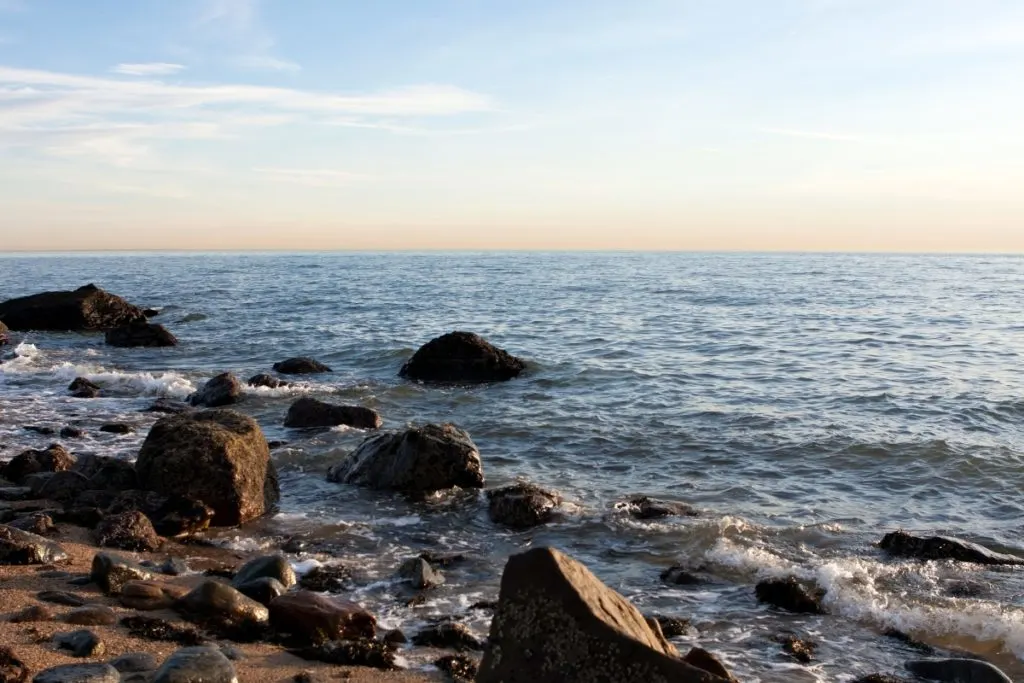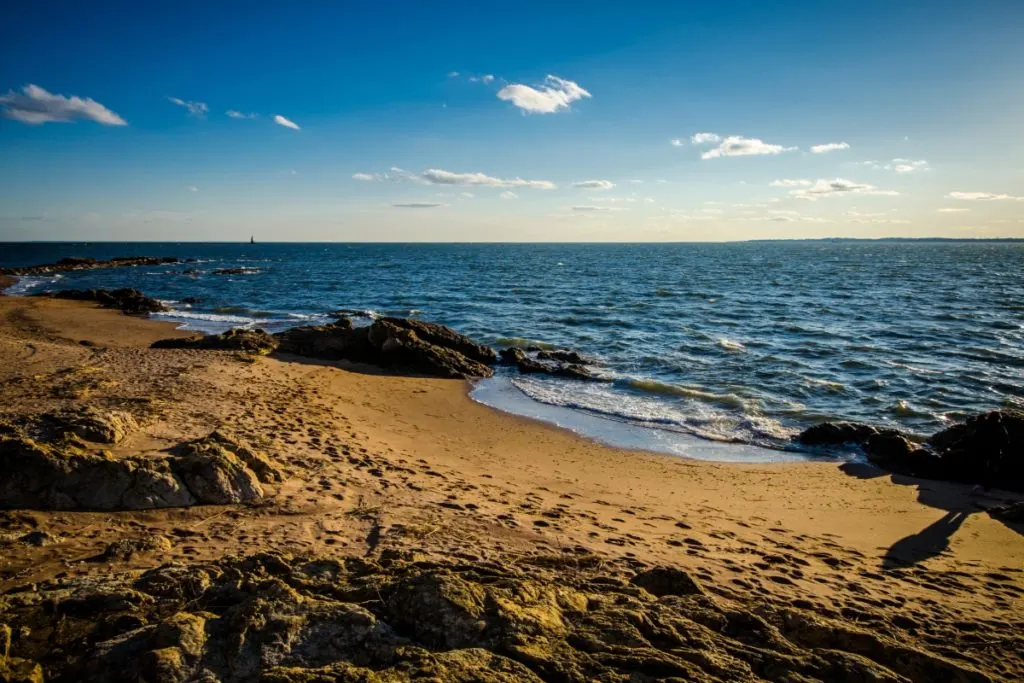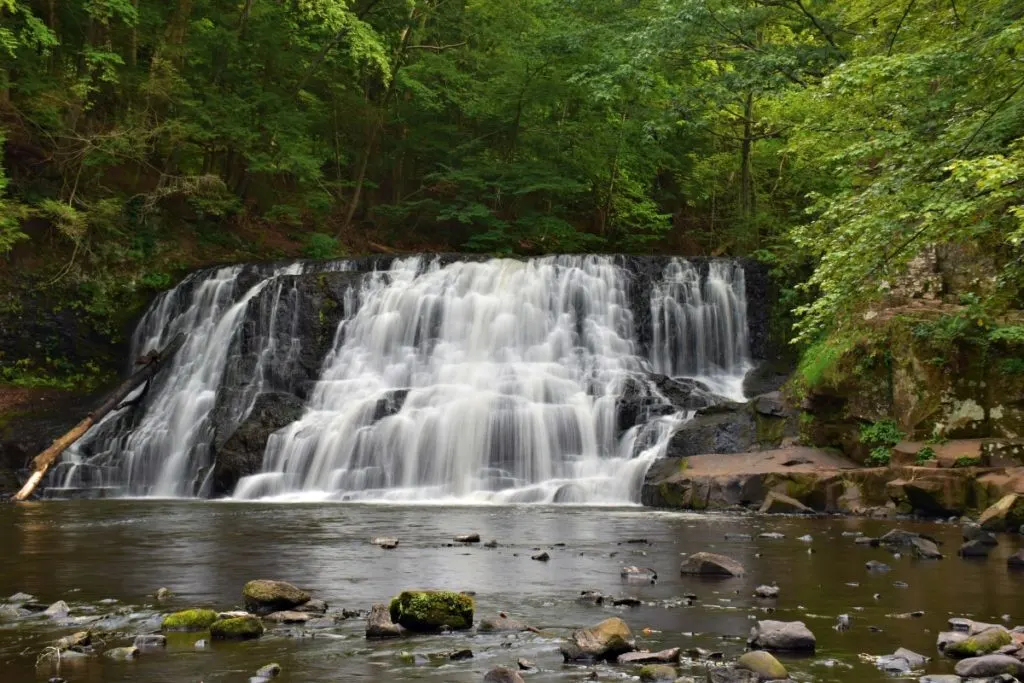As an Amazon Associate, I earn from qualifying purchases with no additional costs for you.
Even though Connecticut is a small state in the U.S., it has some amazing rockhounding spots. There are plenty of rocks, minerals, gemstones, crystals, and fossils you can find here.
The best rockhounding locations in this state include the outcrops of schist and basalt, old mines and quarries, and ocean beaches. The best specimens you can find in Connecticut include agates, garnets, amethyst, gold, diamonds, tourmaline, aquamarine, quartz crystals, citrine, corundum, topaz crystals, and many others.
Let’s see precisely why Connecticut is such an awesome state to collect rocks, what specimens you can find, and where!

If you are interested in checking out the best rockhounding book about rockhounding in Connecticut you can find it by clicking here (Amazon link).
Best Rockhounding Sites & Beaches in Connecticut
The best rockhounding sites and beaches in Connecticut are Hartford County, Litchfield County, Tolland County, Fairfield County, New Haven County, Middlesex County, and New London County. Collins Hill, Long Hill Mine, Tolland, Vernon, East Granby Quarry, Bristol Copper Mine, Roebling Mine, and Old Iron Mine are exceptionally great places.
Let’s explore a couple of these areas and see exactly why they are such great spots for rockhounding or beachcombing.
Litchfield County
Litchfield County, Connecticut, is a fantastic region for rockhounding as there are many spots to choose from. For example, the area exposures of mica schist often reveal corundum, staurolite, pyrite, or talc specimens.
Rose quartz can be found on the south side of Bantam Lake. The Roebling Mine though, near New Milford, takes the cake. Here you can find tourmaline, aquamarine, beryl, biotite and feldspar minerals, garnet, smoky quartz, and muscovite.
Near Mine Hill, at Old Iron Mine, you can find quartz crystals, pyrite, galena, chalcopyrite, siderite, and sphalerite. If you want to find prehnite or agates, go to Torrington, in the area of basalt sills.
Hartford County
Hartford county is another excellent area for rockhounding in Connecticut. Here, if you head to the Bristol Copper Mine, chances are you will find chalcocite crystals, bornite, calcite, chalcopyrite, chrysocolla, or malachite.
Amethyst is commonly found in Canton, in the quartz vein exposure of the local stream. However, at the East Granby Quarry in Hartford county, you can find gem-quality datolite specimens, calcite, aragonite, calcite, celestine, epidote, fluorite, prehnite, galena, quartz, and various others things.
The area quarries near Meriden are also popular locations where amethyst, calcite, gypsum, and quartz specimens have been found. Aquamarine, and smoky quartz specimens, are located at old Simpson Quarry, Glastonbury.
Tolland County
The many outcrops and road cuts in Tolland county, Connecticut, are fantastic for rockhounding. In the Tolland and Vernon area schist exposures, explorers may find rose quartz specimens, alongside garnets, and staurolite specimens.
In Union, the road cut just south of Bigelow Pond is where you can find cordierite, moonstone, and feldspar.
Middlesex County
Middlesex County, Connecticut, is home to numerous old mines and quarries. Some require fees, while others are free so it’s important to do your research beforehand.
One popular fee quarry here is the Gillette Quarry, Haddam. Here you may find garnet, quartz crystals, amazonite, aquamarine, beryl, chrysoberyl, and tourmaline.
At Collins Hill, the west side near peak, explorers may find spodumene, tourmaline, apatite, aquamarine, beryl, citrine, bismuthinite, columbite, feldspar, and rose, smoky, or clear quartz specimens.
BTW: Do you want to know more about rock and mineral identification? The books listed below are the best ones you can find on the internet (Amazon links):
- Smithsonian Handbooks: Rocks & Minerals
- Gemstone & Crystal Properties (Quick Study Home)
- Ultimate Explorer Field Guide: Rocks and Minerals (National Geographic Kids)
Best Beaches in Connecticut for Beachcombing
Connecticut has many beautiful beaches where beachcombing may yield some awesome discoveries. Sea glass is commonly found in certain areas.
The best beaches in Connecticut for beachcombing are Sandy Point Beach, West Haven, Harvey’s Beach, Old Saybrook, McCook Point Beach, East Lyme, Cove Island Park, Stamford, Silver Sands State Park, Milford, DuBois Beach, Stonington, Hammonasset State Park, Madison, Eastern Point Beach, Sherwood Island State Park, Westport, and Bluff Point.
TIP: Hunting for rocks at the seaside is a pleasurable pastime, and there are many treasures to be found. Check out simple ways how to clean the beach rocks in the article below:
Cleaning Rocks From the Beach: 7 Ways How to Do It Properly
Best Rockhounding Clubs in Connecticut
Rockhounding anywhere isn’t as great without new acquaintances that share the same passion. In Connecticut, there are various rockhounding clubs that you can join and learn more about specific locations, or even find new ones.
The best rockhounding clubs in Connecticut that you may want to join are Bristol Gem & Mineral Club, Danbury Mineralogical Society, Manchester Gem & Mineral Club, Meriden Mineral Club, New Haven Mineral Club, Stamford Mineralogical Society, and Thames Valley Rockhounds, among many others.
Types of Rocks and Gemstones in Connecticut

If you are in Connecticut, there are various rocks and gemstones to be found. Some of the common rocks you can find in Connecticut include geodes, flint, agate, asbestos, soapstone, staurolite, moonstone, whetstone, limestone, and even serpentine, among others. Geodes are rare, but they are certainly present in Connecticut.
| Rock | Location |
|---|---|
| Geodes | Durham, Guilford, Naugatuck State Forest |
| Flint | Fairfield County, Middlesex County, New Haven County |
| Agate | Torrington, Farmington, Guilford & East Haven, Plum Bank Beach |
Finding geodes in Connecticut is hard, but not without its rewards. Some geode specimens can be found around Durham, or in the northern regions of Guilford, in the area outcrops. Naugatuck State Forest is also a potential location to find geodes in Connecticut.
When it comes to flint in Connecticut, there are several places you can search for. In Fairfield County, you may find flint in Stamford, the Dyke Park. In Middlesex County, you can find flint in Haddam. New Haven County is also a potential location to find natural flint, especially near Woodbridge.
Moving on to the cooler rocks, or gemstones, there are several types you can find in Connecticut. Some of the most popular gemstones that you can find in Connecticut include amethyst, pyrite, aquamarine, gem-quality datolite, topaz, tourmaline, amazonite, danburite, and the beautiful and rare chrysoberyl, among many others.
TIP: As you explore Connecticut, find out the most common rocks and minerals you can find in the article below:
9 Common Rocks & Minerals You Can Find in Connecticut
| Gemstone | Location |
|---|---|
| Amethyst | Canton, Meriden, Cinque Quarry, New Haven Traprock Quarry |
| Tourmaline | Roebling Mine, Gillette Quarry, White Rocks Quarry, Collins Hill |
| Aquamarine | Old Simpson Quarry, Roebling Mine, Riverside Quarry, Walden Gem Quarry |
Aquamarine is easily found in Connecticut. If you head to Litchfield County, at the Roebling Mine, you can find aquamarine at New Milford. In Hartford County, aquamarine is found at the Old Simpson Quarry, Glastonbury. Middlesex County is, however, the best region in Connecticut to find aquamarine gemstones.
You can head towards the Gillette Quarry, Haddam, but you can only enter by paying a fee. The Riverside Quarry also has aquamarine specimens, as well as the Walden Gem Quarry. You can also find aquamarine at Collins Hill, the west side near the peak.
When it comes to finding amethyst gemstones in Connecticut, your best luck is in either Hartford County or New Haven County. In Hartford County, you can find amethyst in Canton, in the quartz vein exposure in the local stream.
You can also go to Meriden, and search the area quarries. In New Haven, you can find amethyst at the Cinque Quarry, East Haven, or go to the New Haven Traprock Quarry.
Tourmaline can be found in Connecticut in Litchfield County, or Middlesex County. In Litchfield County, you can find tourmaline specimens at the Roebling Mine, New Milford.
However, it would be better to go to Middlesex County as there are four major locations to find a tourmaline.
The first one is Gillette Quarry, Haddam, but with a fee. Long Hill/Turkey Hill Prospects are also good locations, but again, you have to pay a fee. The White Rocks Quarry or at Collins Hill, the west side near peak, are also excellent locations to find tourmaline.
TIP: Agates can be cut into slices – perfect for wearing as jewelry – or they can simply be cut in half, as a beautiful specimen for your rock shelf. Check out the complete guide in the article below:
How to Cut and Polish Agates? Follow These Simple Steps
What Minerals and Crystals Can You Find in Connecticut?

Connecticut shines in its diversity of minerals. You can find gold, garnet, quartz, tourmaline, actinolite, beryl, biotite, feldspar, muscovite, chalcopyrite, galena, siderite, prehnite, bornite, calcite, malachite, aragonite, pegmatite, cuprite, gypsum, bog iron ore, limonite, calamine, wolframite, or sillimanite, among others.
| Mineral | Location |
|---|---|
| Gold | Litchfield County |
| Garnet | Roebling Mine, Tolland, Vernon, Gillette Quarry |
| Quartz | Bantam Lake, East Granby Quarry, Old Simpson Quarry, Peloton’s Quarry |
With such a variety of minerals, many wonders if diamonds can be found in Connecticut. Unfortunately, there haven’t been any records of diamonds discovered within the state.
If they were discovered, diamonds would most likely have been brought here from other states through natural phenomena.
Gold, on the other hand, is just as hard to find in Connecticut. The most known occurrences took place in the northwestern parts of Litchfield County, in small glacial deposits. The Thomaston Dam at Leadmine brook, Farmington River northwest of Hartford, and Spruce brook have also minor placer gold deposits.
TIP: If you want to know more about gold prospecting in Connecticut, check out the complete guide in the article below:
Gold Prospecting in Connecticut: 7 Best Locations & Laws
Garnets appear to be popular and numerous in Connecticut though. Almandine garnets are found throughout the state.
Some of the best places to find garnet specimens in Connecticut include the Eisenhower Park, Milford, Salmon River State Forest, Colchester, Hammonasset Beach, Madison, Gerber Lane Road Cut, Tolland, or Quartzite Hill, Stafford.
If you want to find rose quartz in Connecticut, head towards the south side of Bantam Lake, Litchfield County.
Smokey quartz can be found at the Roebling Mine, New Milford, or in Hartford County, at the Old Simpson Quarry, Glastonbury. You can also find quartz in this county at the area quarries in Meriden, or Canton, the exposures of Canton.
Tolland County though is a great place to find various types of quartz. For example, the Tolland and Vernon area schist exposure yields normal and rose quartz specimens.
In Middlesex county, you can find rose, smoky, or clear quartz specimens at the Slocum Prospect, East Hampton, or Collins Hill.
Crystals are also abundant in Connecticut. You can find in Connecticut crystals like corundum, quartz crystals, sphalerite, chalcocite crystals, chrysocolla, celestine, epidote, fluorite, cordierite, cerussite, graphite pyromorphite, arsenopyrite, bismuth, pyrite, topaz crystals, scheelite, citrine, bismuthinite, and spodumene.
| Crystal | Location |
|---|---|
| Quartz Crystals | Old Iron Mine, Tolland, Vernon, Stafford |
| Topaz Crystals | Long Hill Mine in Old Mine Park |
| Chalcocite Crystals | Bristol Copper Mine, Simsbury Mine, Mt. Carmel |
Some beautiful quartz crystals can be found in Connecticut. In Litchfield County, quartz crystals are abundant at the Old Iron Mine at Mine Hill. In Tolland County, you can find quartz crystals at Stafford, in the area of mines and quarries.
Beautiful blue topaz crystals can be found in Fairfield County, at Long Hill Mine in Old Mine Park. Chalcocite crystals were discovered in Hartford County, at the Bristol Copper Mine.
TIP: It’s challenging to differentiate between fake and real garnets without gemological equipment. Check out the main differences between real and fake garnets in the article below:
Real vs. Fake Garnet: Focus on These 6 Differences
Where to Find Fossils in Connecticut?
National parks, state parks, beach areas, and even some private properties have various fossils in Connecticut. Some dinosaur fossils you can find here include the Parasaurolophus walkeri, Camptosaurus dispar, plateosaurus, and chindesaurus bryansmalli.
The most common fossils discovered in Connecticut, apart from dinosaur fossils, are those of brachiopods, and bivalves, like mussels, clams, or snails.
Coastal Connecticut is the favorite spot of rockhounds that want to find shark teeth. Practically, all coastal beaches here, apart from sea glass, have shark teeth fossils just waiting to be discovered.
FAQs About Rockhounding in Texas
Still did not find the answer to your answers about rockhounding in Connecticut? Find frequently asked questions in the section below:
What is the State Mineral of Connecticut?
The official state mineral of Connecticut is the almandine garnet, since 1977. They occur in igneous pegmatites, granites, and metamorphic gneiss or mica schist.
They are prevalent throughout Connecticut, hence why garnets are found all across the state. Garnets vary in color from dark tints to pale specimens, and some have strong hues of violet-red.
What is the State Fossil of Connecticut?
The official state fossil of Connecticut is the Eubrontes Giganteus, from 1991. It is a giant three-toed track, common in the Connecticut Valley, which is among the world’s best dinosaur track locations.
Based on the analysis, it might seem that the dinosaur that left these tracks is related to the western genus Dilophosaurus.
Conclusion
Connecticut is a small state with a big variety of gemstones, minerals, crystals, rocks, and especially fossils. It is a must-visit state for any die-hard rockhounding collector looking to discover new specimens or hunt for rare ones.
TIP: Pebbles are stones that everyone can easily find. There are kilometers of pebbles on the beaches in rivers and lakes. Find out more about these rocks in the article below:
All About Pebble Rocks: What Type of Rock, Forming & More
